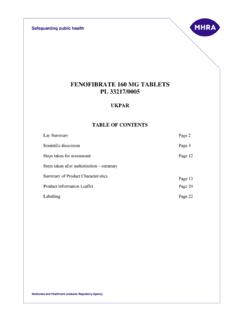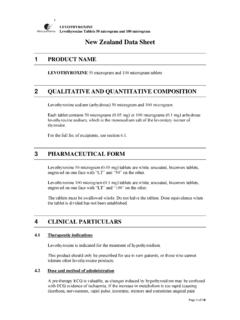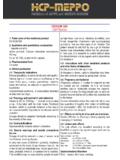Transcription of Guideline on the pharmacokinetic and clinical …
1 1 London, 21 February 2013. 2 EMA/CHMP/EWP/280/96 Rev1. 3 COMMITTEE FOR MEDICINAL PRODUCTS FOR HUMAN USE (CHMP). 4 Guideline on the pharmacokinetic and clinical evaluation 5 of modified release dosage forms 6 (EMA/CPMP/EWP/280/96 Corr1). 7 Draft XXIII. Draft Agreed by Pharmacokinetics Working Party October 2012. Adoption by CHMP for release for consultation 21 February 2013. Start of public consultation 15 March 2013. End of consultation (deadline for comments) 15 September 2013. 8. 9 This Guideline replaces Guideline on Modified Release Oral and Transdermal Dosage Forms Section II. 10 ( pharmacokinetic and clinical evaluation (EMA/CPMP/EWP/280/96 Corr*)). 11. Comments should be provided using this template. The completed comments form should be sent to 12. Keywords Modified release, prolonged release, delayed release, transdermal drug delivery systems (TDDS), bioequivalence, pharmacokinetics, biowaiver, in vitro dissolution, generics 13.
2 7 Westferry Circus Canary Wharf London E14 4HB United Kingdom Telephone +44 (0)20 7418 8400 Facsimile +44 (0)20 7418 8416. E eb ite An agency of the European Union European Medicines Agency, 2013. Reproduction is authorised provided the source is acknowledged. 14 Guideline on the pharmacokinetic and clinical evaluation 15 of modified release dosage forms 16 (EMA/CPMP/EWP/280/96 Corr1). 17 Table of contents 18 Executive summary .. 4. 19 1. Introduction (background) .. 4. 20 Types of Modified release and dosage forms .. 4. 21 Rationale for Development .. 5. 22 The clinical rationale .. 5. 23 Considerations for use and posology .. 5. 24 2. 6. 25 3. Legal basis and relevant guidelines .. 6. 26 4. Applications for modified release dosage forms of new chemical entities 7. 27 pharmacokinetic studies required for MR formulation of a new chemical entity.
3 7. 28 Food effect studies with oral modified release forms .. 8. 29 pharmacokinetic Studies required for Transdermal Drug Delivery Systems (TDDS) of a 30 new chemical entity .. 8. 31 pharmacokinetic Studies required for intramuscular/subcutaneous Depot formulations of 32 a new chemical entity .. 9. 33 5. Application for a modified release formulation of a substance that is 34 authorised as an immediate release formulation .. 9. 35 pharmacokinetic studies .. 9. 36 Rate and extent of absorption, fluctuation .. 10. 37 Variability .. 11. 38 Dose 11. 39 Factors affecting the performance of a modified drug formulation .. 11. 40 Other points to consider .. 13. 41 Therapeutic studies .. 14. 42 Waiving of therapeutic studies .. 14. 43 How to design clinical studies .. 14. 44 6. Abridged application for modified release forms referring to a marketed 45 modified release form.
4 15. 46 Prolonged release formulations for oral administration .. 16. 47 Strength(s) to be evaluated .. 17. 48 Delayed release formulations .. 18. 49 Strength(s) to be evaluated .. 18. 50 Prolonged residence time in the stomach .. 19. 51 Multiphasic modified release products .. 19. 52 Intramuscular/Subcutaneous Depot Formulations .. 20. Guideline on the pharmacokinetic and clinical evaluation of modified release dosage forms (EMA/CPMP/EWP/280/96 Corr1). 2/38. 53 Strength to be evaluated .. 20. 54 Transdermal Drug Delivery Systems (TDDS) .. 20. 55 Strength to be evaluated .. 20. 56 Bracketing approach .. 21. 57 New strength for an already approved MR product .. 21. 58 evaluation .. 21. 59 Parameters to be 21. 60 Acceptance criteria .. 22. 61 Effects of alcohol .. 22. 62 Further points to consider for bioequivalence studies .. 22. 63 Definitions.
5 24. 64 Appendix I (sensitisation and irritation test for transdermal products) .. 25. 65 Appendix II (In vitro in vivo correlation): .. 29. 66 Appendix III: Summary of study recommendations for abridged 67 applications: .. 35. 68. Guideline on the pharmacokinetic and clinical evaluation of modified release dosage forms (EMA/CPMP/EWP/280/96 Corr1). 3/38. 69 Executive summary 70 The primary purpose of this Guideline is to define the studies necessary to investigate the efficacy, 71 safety, biopharmaceutic and pharmacokinetic properties of modified release and transdermal dosage 72 forms in man and to set out general principles for designing, conducting and evaluating such studies. 73 The revision of the Note for Guidance on the Investigation of Bioavailability and Bioequivalence 74 (EWP/QWP/1401/98) generated the necessity of consequential adjustments.
6 Furthermore the Guideline 75 provides updated requirements for transdermal drug delivery systems (TDDS) and addresses 76 recommendations for specific modified release formulations, for intramuscular/subcutaneous depot 77 formulations. 78 1. Introduction (background). 79 Types of Modified release and dosage forms 80 Modified release dosage forms are formulations where the rate and/or site of release of the active 81 ingredient(s) is different from that of the immediate release dosage form administered by the same 82 route. This deliberate modification is achieved by special formulation design and/or manufacturing 83 methods. Modified release dosage forms covered by this Guideline include orally, intramuscularly, 84 subcutaneously administered modified release and transdermal dosage forms. 85 Prolonged release dosage forms: Prolonged release dosage forms are modified release 86 dosage forms showing a slower release than that of an immediate release dosage form 87 administered by the same route.
7 88 Delayed release dosage form: The release of the active substance from such modified 89 release dosage forms is delayed for a certain period after administration or application of the 90 dosage. The subsequent release is similar to that of an immediate release dosage form. 91 Multiphasic release dosage forms: 92 o Biphasic Release: The first phase of drug release is determined by the immediate 93 release dose fraction providing a therapeutic drug level shortly after administration. 94 The second extended release phase provides the dose fraction required to maintain an 95 effective therapeutic level for a prolonged period. 96 o Pulsatile Release: Pulsatile drug release is intended to deliver a burst of drug release 97 at specific time intervals. 98 Multiple-unit: A multiple unit dosage form contains a plurality of units pellets or beads 99 each containing release controlling excipients, in a gelatine capsule or compressed in a 100 tablet 101 Single-unit: The single-unit dosage forms consist of only one unit, osmotic tablet.
8 102 Intramuscular/subcutaneous Depot formulations: A depot injection is usually a 103 subcutaneous or intramuscular product which releases its active compound continuously over a 104 certain period of time. Subcutaneous depot formulations include implants. 105 Transdermal drug delivery systems (TDDS): A TDDS or transdermal patch is a flexible 106 pharmaceutical preparation of varying size containing one or more active substance(s) to be 107 applied on the intact skin for systemic availability. Guideline on the pharmacokinetic and clinical evaluation of modified release dosage forms (EMA/CPMP/EWP/280/96 Corr1). 4/38. 108 There are two main types of transdermal patch systems depending on how the drug substance 109 is dispersed in other patch components: matrix and reservoir systems. Drug release from 110 matrix systems is based on the diffusion of soluted drug substance from the patch.
9 Reservoir 111 systems contain a specific liquid drug compartment and release is controlled by a membrane. 112 Rationale for Development 113 The development of a modified release formulation has to be based on a well-defined clinical need and 114 on an integration of physiological, pharmacodynamic and pharmacokinetic considerations. 115 The dossier submitted in support of an application for a marketing authorisation must provide a 116 complete justification of: 117 The physical form of the modified release device and the mechanism of the release form;. 118 The choice of the dosage form, defining the in vitro and in vivo performance of the product;. 119 The choice of active substance contents per unit of the dosage form;. 120 The clinical rationale for the new dosage form, particularly in relation to the proposed 121 indications and posology.
10 122 The clinical rationale 123 A prolonged release dosage form may be acceptable if the active substance can produce the desirable 124 clinical effect with a different PK profile than that resulting from an immediate-release form. A. 125 prolonged release formulation may offer the following advantages over an immediate-release form: 126 reduced fluctuations in drug plasma concentrations, which may result in more continuous 127 effects and/or reduced incidence and/or intensity of adverse drug reactions, 128 lower frequency of administration and thereby potentially improvement of patient compliance. 129 non-oral route of administration (IM/SC and TDDS). 130 A biphasic modified release form may be considered if a rapid onset of action is required in addition to 131 subsequent prolonged release characteristics. 132 Development of a delayed release dosage form may be considered to protect the active substance from 133 the acid environment of the stomach, to protect the stomach from the active substance, or when the 134 active substance is intended to be released in a defined segment of the intestine.















